My Calls
In Thursday’s blog post my favorite image was #3, the preening Sandwich Tern because of the low perspective, the sweet light, the beautiful bird, and the perfect preening pose. As for which image had the best low perspective/background combination, I’d go with #4, the young Royal Tern images that was made with the lens hood resting on the sand.
Your Call?
Which of today’s five flight images is the strongest. Please leave a comment letting us know any you made your choice. New folks are always welcome so don’t be shy.
|
|
|
San Diego offers a wealth of very attractive natural history subjects, including and especially the Pacific race of California Brown Pelican. With annual visits spanning more than four decades, I have lots of photographic experience there … Click on the composite to enjoy a larger version. |
The 2023/2024 San Diego Brown Pelicans (and more!) IPTs
IPT #2: 3 1/2 DAYS: WED 31 JAN thru the morning session on SAT 3 FEB, 2024: $2149.00. Limit: 6 photographers
San Diego IPT: 4 1/2 DAYS: TUES 23 JAN thru the morning session on SAT 27 JAN 2024: $2699.00. Deposit: $699.00. Limit: 6 photographers/Openings: 4.
Please e-mail for information on personalized pre- and post-IPT sessions.
Join me in San Diego to photograph the spectacular breeding plumage Brown Pelicans with their fire-engine red and olive green bill pouches; Brandt’s (nesting) and Double-crested Cormorants; breeding plumage Wood and Ring-necked Ducks; other duck species possible including Lesser Scaup, Redhead, Northern Shoveler and Surf Scoter; a variety of gulls including Western, California, and the gorgeous Heermann’s, all in full breeding plumage; shorebirds including Marbled Godwit, Willet, Sanderling and Black-bellied Plover; many others are possible including Least, Western, and Spotted Sandpiper, Whimbrel, Black and Ruddy Turnstone, Semipalmated Plover, and Surfbird; Harbor Seals and California Sea Lions (both depending on the current regulations and restrictions). And as you can see by studying the IPT cards, there are some nice bird-scape and landscape opportunities as well. Not to mention a ton of excellent flight photography opportunities and instruction.
I discovered some really neat new spots on my 2022/23 visit. As a result, the first and second IPTs may include an afternoon or two of landscape photography.
Please note: where permitted and on occasion, ducks and gulls may be attracted (or re-located) with offerings of grains or healthy bread.
|
|
|
San Diego offers a wealth of very attractive natural history subjects, including and especially the Pacific race of California Brown Pelican. With annual visits spanning more than four decades, I have lots of photographic experience there … Click on the composite to enjoy a larger version. |
Learning Exposure, Whether You Like It Or Not
Whether you like it or not, we will be beating the subject of exposure like a dead horse. In every new situation, you will hear my thoughts on exposure along with my thoughts on both Nikon and Canon histograms and SONY Zebras. Whether you like it or not, you will learn to work in manual mode so that you can get the right exposure every time (as long as a bird gives you ten seconds with the light constant). Or two seconds with SONY zebras … And you will learn what to do when the light is changing constantly. What you learn about exposure will be one of the great takeaways on every IPT.
|
|
|
Though the pelicans will be the stars of the show on this IPT, there will be many other handsome and captivating subjects in wonderful settings. Click on the composite to enjoy a larger version. |
It Ain’t Just Pelicans
With gorgeous subjects just sitting there waiting to have their pictures taken, photographing the pelicans on the cliffs is about as easy as nature photography gets. With the winds from the east almost every morning, there is usually some excellent flight photography, at times with 70-200mm lenses! And the pelicans are almost always doing something interesting: preening, scratching, bill pouch cleaning, or squabbling. And then there are those crazy head throws that are thought to be a form of intra-flock communication. You will be guided as to how to make the best of those opportunities. Depending on the weather, the local conditions, and the tides, there are a variety of other fabulous photo chances available in and around San Diego. Each IPT will include one or two duck sessions.
|
Did I mention that there are lots of great birds and natural history subjects in San Diego in winter? Click on the composite to enjoy a larger version. |
The San Diego Details
These IPTs will include four or five 3-hour morning photo sessions, three or four 1 1/2-hour afternoon photo sessions, and three or four working brunches that will include image review and Photoshop sessions. On rare cloudy days, we may — at the leader’s discretion, stay out in the morning for a long session and skip that afternoon shoot. To ensure early starts, breakfasts will be your responsibility. And so that we can get some sleep, dinners will be on your own as well. In the extremely unlikely event that Goldfish Point is closed due to local ordinance (or whimsy) — that has never happened in the past fifty years, I will of course do my very best to maximize our photographic opportunities.
Deposit Info
A $699 deposit is required to hold your slot for one of the 2024 San Diego IPT. You can send a check (made out to “BIRDS AS ART”) to us here: BIRDS AS ART, PO Box 7245, Indian Lake Estates, FL, 33855, or call Jim or Jennifer at the office with a credit card at 863-692-0906. Your balance, payable only by check, is due three months before the trip.
|
Variety is surely the spice of life in San Diego. Click on the composite to enjoy a larger version. |
Getting Up Early and Staying Out Late
On all BIRDS AS ART IPTS including and especially the San Diego IPT, we get into the field early to take advantage of unique and often spectacular lighting conditions and we stay out late to maximize the chances of killer light and glorious sunset silhouette situations. We often arrive at the cliffs a full hour before anyone else shows up to check out the landscape and seascape opportunities.
What’s Up?
Wednesday afternoon at DeSoto was excellent if you knew where to be. I was in the right spot when the forecast strong northeast wind (bad) switched to a gentle and variable breeze from the northwest (perfect). Thursday morning was decent with the highlight for me being a very tame first winter Greater Yellowlegs before sunrise. My drive home in the afternoon was a piece of cake and I got in a late 30-length swim in the 74.3° pool. Chilly, for sure. I spent Friday catching up and headed over to Sebastian Inlet in the afternoon.
Today is Saturday 21 October 2023. Wherever you are an whatever you are doing, I hope that you too have a great day.
Please remember to use the B&H and Amazon links that are found on most blog pages and to use the BIRDSASART discount code at checkout when purchasing your new gear from Bedfords to get 3% back on your credit card and enjoy free second-day air FedEx. Please, also, consider joining a BAA IPT. You will be amazed at how much you will learn!
You can find some great photo accessories (and necessities, like surf booties!) on Amazon by clicking on the Stuff tab on the orange/yellow menu bar above. On a related note, it would be extremely helpful if blog-folks who, like me, spend too much money on Amazon, would get in the habit of clicking on the Amazon logo link on the right side of each blog post when they shop online. As you might expect, doing so will not cost you a single penny, but would be appreciated tremendously by yours truly. And doing so works seamlessly with your Amazon Prime account.
If an item — a Delkin flash card, or a tripod head — for example, that is available from B&H and/or Bedfords, is also available in the BAA Online Store, it would be great, and greatly appreciated, if you would opt to purchase from us. We will match any price. Please remember also to use my B&H affiliate links or to earn 3% cash back at Bedfords by using the BIRDSASART discount code at checkout for your major gear purchases. Doing either often earns you free guides and/or discounts. And always earns my great appreciation.
|
|
|
This image was created on 25 December 2022 at La Jolla, CA. Standing at full height, I used the handheld Sony FE 200-600mm f/5.6-6.3 G OSS lens (at 347mm) and The One, the Sony Alpha 1 Mirrorless digital camera. ) The exposure was determined using Zebra technology with ISO on the Thumb Dial. ISO 1250. 1/3200 second at f/6.3 (wide-open) in Manual Mode. AWB at 7:48:15am on a sunny morning. RawDigger showed the raw file brightness to be dead solid perfect. Tracking: Zone/AF-C with Bird Face/Eye Detection performed perfectly. Be sure to click on the image to enjoy a larger, sharper, high-res version. Image #1: Pacific-race Brown Pelican, juvenile braking to land
|
THE Best Lens for Pelican Flight Photography In La Jolla
If you own only a single lens, then it is obviously THE best lens for flight photography for you. If you own more than one super-telephoto, telephoto, or telephoto zoom lens, then THE best lens can be determined only after evaluating the situation, the sky conditions and the light, the wind speed and direction, and the flight patterns of the birds. Note that each of today’s five featured images was created with a different rig with focal lengths ranging from 180 to 840mm.
To learn to evaluate a variety of flight photography situations live and in person, consider joining me on one of the two San Diego IPTs listed above.
Depth of Field Question #1
Why is there more background detail in the ocean Image #1 than in Images #3 and 4?
The Sony 200-600
On sunny days, the 200-600, with its relatively light weight, incredible versatility, and its 600mm each (when needed), can be an ideal for flight at La Jolla. It is also quite useful for photographing perched birds and all sorts of pelican behaviors.
|
|
|
This image was created on 27 December 2022 at La Jolla, CA. Standing at full height, I used the Robus RC-5558 Vantage Series 3 Carbon Fiber Tripod/Levered-Clamp FlexShooter Pro-mounted Sony FE 600mm f/4 GM OSS lens and The One, the Sony Alpha 1 Mirrorless digital camera. ISO 500. Exposure was determined via Zebras with ISO on the rear dial: 1/3200 sec. at f/4 (wide open). AWB at 9:07:11 am on a foggy-bright morning. Tracking: Zone/AF-C was active at the moment of exposure and performed perfectly. Be sure to click on the image to enjoy the larger version. Image #2: Pacific-race Brown Pelican, flock of six in flight over a breaking wave |
A Realization
After five decades of visiting La Jolla, I realized that one of my favorite mid-morning spots for gulls, terns, and shorebirds would be great for photographing the pelicans soaring over the tops of breaking waves. A super-telephoto lens with or without the 1.4X TC is perfect as the birds are not usually flying by at close range.
Aging Pelicans
Aging a bird refers to identifying the plumage. In this image, there are four young birds, two in breeding plumage, and one sub-adult. Can you locate each of those?
Depth of Field Question #2
Even though the subjects are not on the exact same plane, they are all relatively sharp on the face?
|
|
|
This image was created on 2 January 2023 at La Jolla, CA. Standing at full height, I used the Robus RC-5558 Vantage Series 3 Carbon Fiber Tripod/Levered-Clamp FlexShooter Pro-mounted Sony FE 600mm f/4 GM OSS lens with the Sony FE 1.4x Teleconverter, and The One, the Sony Alpha 1 Mirrorless Digital Camera.. ISO 1600: 1/2500 second at f/5.6 (wide open) in Manual mode. AWB at 10:32:34am in bright overcast conditions. Tracking Zone/AF-C with Bird Face/Eye detection enabled performed perfectly. Be sure to click on the image to enjoy the larger, sharper, high-res version. Image #3: Pacific-race Brown Pelican, sub-adult in flight |
A New Spot
In 2022/23, I discovered a new spot that was great for flight photography, mostly for pelicans and Royal Terns with occasional fly-by Brandt’s Cormorants. A variety of focal lengths can be excellent at this location as the birds sometimes fly right by at close range and sometimes are rather distant.
|
|
|
This image was created on 4 January 2023 at La Jolla, CA. Standing at full height, I used the handheld Sony FE 400mm f/2.8 GM OSS lens and The One, the Sony Alpha 1 Mirrorless Digital Camera). The exposure was determined via Zebra technology with ISO on the Thumb Dial. ISO 400. 1/4000 sec. at f/3.5 (stopped down 1/3-stop) in Manual mode. When evaluated in RawDigger, the raw file exposure was determined to be dead-solid perfect (ho hum). AWB at 9:33:28am on clear sunny morning. Tracking: Zone/AF-C with Bird Face/Eye detection enabled performed to perfection. Be sure to click on the image to enjoy the larger, sharper, high-res version. Image #4: Pacific-race Brown Pelican breeding plumage adult — downstroke flight pose |
The 400mm f/2.8
Despite the fact that the Sony 400 f/2.8 GM lens is only 4 ounces lighter than the 600mm f/4 GM, I will use the 600mm f/4 on a tripod 99% of the time while almost always handholding the 400mm f/2.8. Why? The super-fast 400mm is physically smaller (shorter) than the 600 and is far better balanced with the bulk of the weight towards the rear of the lens.
The 400mm f/2.8 was especially perfect for flight on my 20223/2023 San Diego visit as the usually perfect weather was on the iffy side with more cloudy, foggy, drizzly weather than I have ever experienced in usually sunny California. The super-wide aperture is a big plus in low light conditions. But is does well on sunny days too. And the focal length is often spot on for the pelicans flying in to land.
|
|
|
This image was created on 5 January 2023 at La Jolla, CA. Standing at full height, I used the handheld I used the Sony FE 70-200mm f/2.8 GM OSS II lens (at 180mm) and The One, the Sony Alpha 1 Mirrorless Digital Camera.. The exposure was determined via Zebras with Exposure Compensation on the thumb dial. ISO 1600: 1/2500 sec. at f/2.8 (wide open) in Manual mode. AWB at 9:08:09 am in the shade on a cloudy morning. Tracking: Zone AF/C with Bird-Eye/Face Detection performed perfectly. Click on the image to enjoy a high-res version. Image #5: Brown Pelican, Pacific-race breeding plumage adult in flight in cove |
The Right Lens for the Situation
The lens choice here best illustrates the horses for courses theme of today’s post. The birds were flying by at close range and it was dark so the 70-200mm GM II lens without a TC was the obvious best choice.
From UsingEnglish.com:
Horses for courses means that what is suitable for one situation might be unsuitable for another.
If you are blessed like me an own several big lenses, you need to learn to evaluate different flight photography situations so that you have the right lens in your hands at the right moment. With experience, you can learn to make the right choice before you leave your vehicle! The best way to learn this stuff is, of course, to join an IPT with San Diego or Homer leading the league in flight photography.
|
|
|
Click on the composite to view a larger version and be even more impressed. The Art & Science of Photographing Birds in Flight with the Sony α-1
|
The Art & Science of Photographing Birds in Flight with the Sony α-1
by Arash Hazeghi and Arthur Morris
First of all, if you use Nikon or Canon (or Olympus or Fuji) gear, do not be put off by the title. While a portion of the guide deals with the Sony α-1, there is a ton of priceless information, tips, and techniques that can help you become a better flight photographer. No matter what system you are using. If you do not use an α-1, be sure to read down to the bottom to save a few bucks.
Arash Hazeghi and Arthur Morris have created the definitive and most comprehensive ever treatise on photographing birds in flight. With more than sixty years of experience photographing birds, they know what you need to know but have not figured out yet! You will be astounded by the depth of their knowledge and the tips they have to offer. More than six months in the making, the guide contains 229 pages, 24,321 words,97 exceptional and inspirational flight images — each with a legendary, enlightening BIRDS AS ART caption, and 22 screen captures. The guide contains a wealth of useful, practical, and for the most part — never-before-available information.
Purchase
Click here to purchase your copy in the BAA Online Store.
What Everyone Will Learn
We will teach you the basic concepts that you need to master to become a great flight photographer along with the techniques used by the world’s best flight photographers.
You will learn that most any telephoto lens can be perfect for flight photography in a given situation; focal lengths for the images in the book range from 200mm to 1200mm and everywhere in between.
We discuss the merits of various lenses in depth, including and especially comparing the 400mm f/2.8 lenses with the 600mm f/4s.
We guide you in getting your hands on the flight photography lens that will best meet your needs. We offer a variety of handholding and rest position tips and include tips on working with a big lens on a tripod when working with a flight lens that is otherwise too heavy for you.
Both authors offer their thoughts on getting the right exposure when photographing birds in flight. You will learn to get the right exposure on foggy days and even when photographing black birds in white sky conditions.
You will learn the tremendous importance of pre-focusing, of finding the bird in the viewfinder quickly, acquiring focus almost instantly (with tips on doing all three).
You will learn the role of image stabilization in flight photography and the best settings.
Both authors share their thoughts on using the focus range limiter switch. In the same vein, you will learn to use Direct Manual Focus to make your flight photography life easier.
All will learn about the best wing positions and the importance of the background with images of birds in flight. With lots of examples.
You will learn about the best shutter speeds (and the best aperture) to use when photographing flying birds.
You will learn to photograph flight while seated and the many advantages of doing so.
You will learn the best methods of controlling high ISO noise.
All will learn to format their flash cards properly and safely.
You will learn what to do when your AF system is temporarily blinded.
All will learn the huge effect that wind strength and direction has on flight photography and to evaluate the quality and direction of the light on both sunny and cloudy days.
You will learn why it is vitally important to shoot aggressively when photographing birds in flight.
You will learn to carefully observe and evaluate a variety of bird behaviors that may shine light on some excellent opportunities for photographing birds in flight. And about getting into the best position from which to photograph.
You will learn to be a much better flight photographer.
What Sony Folks Will Learn
Exactly how Artie uses Zebras to come up with perfect exposure after perfect exposure.
The fine points and recommended settings for Optical Steady Shot (OSS).
The concept of Auto-Focus (AF) tracking in the α-1.
Everything there is to know about the complex Sony autofocus system.
About all the AF patterns, how to quickly switch them, and about those favored by each author. And why.
The Tracking and Non-tracking AF patterns. When and why Arash uses Non-Tracking Zone. And why Artie uses only two AF patterns.
How to set and use Bird Face-Eye detection for flight photography.
How and why to assign various custom functions to the various programmable buttons on the α-1 body.
The perfect settings for the many, many Menu items that are vitally related to flight photography.
How and why the Sony α-1 uses both contrast and phase detection AF to determine focus (and the benefits thereof).
Which are the best memory cards for the Sony α-1.
To quickly access frequently used menu items.
Non-Sony α-1 Discount
Using the honor system, folks who do not use a Sony α-1 body are invited to click here to save $25.00 on the purchase price of the guide.
Typos
With all blog posts, feel free to e-mail or to leave a comment regarding any typos or errors.

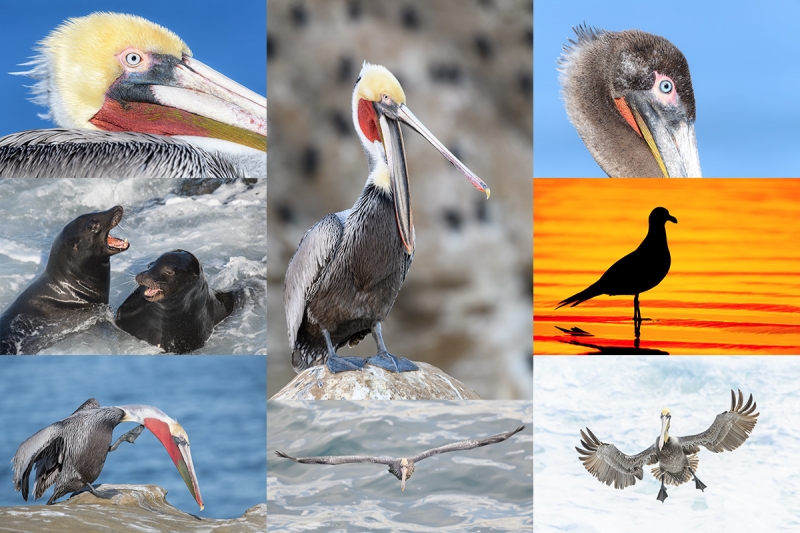
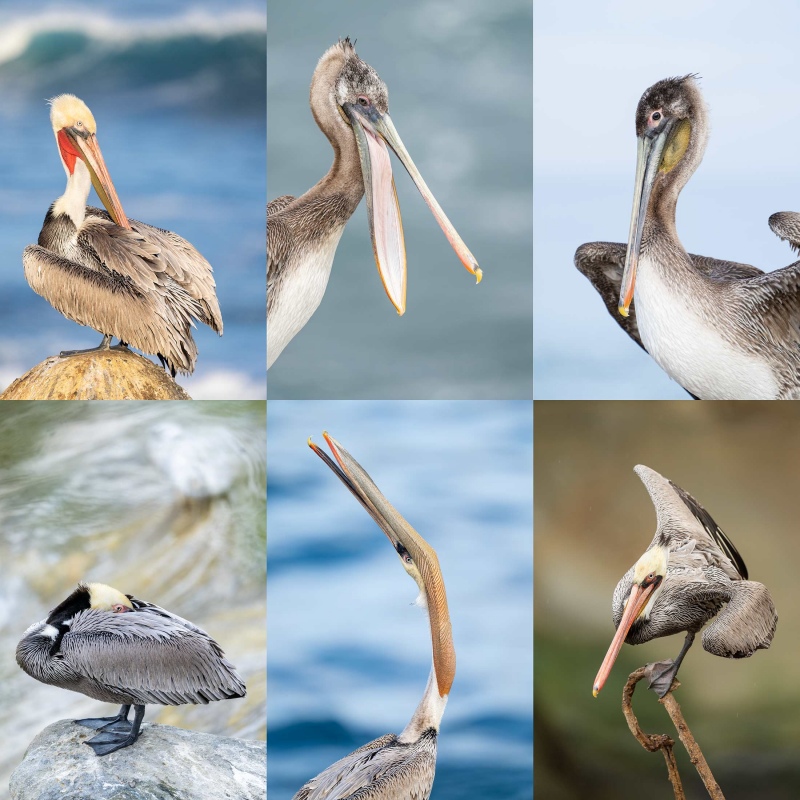
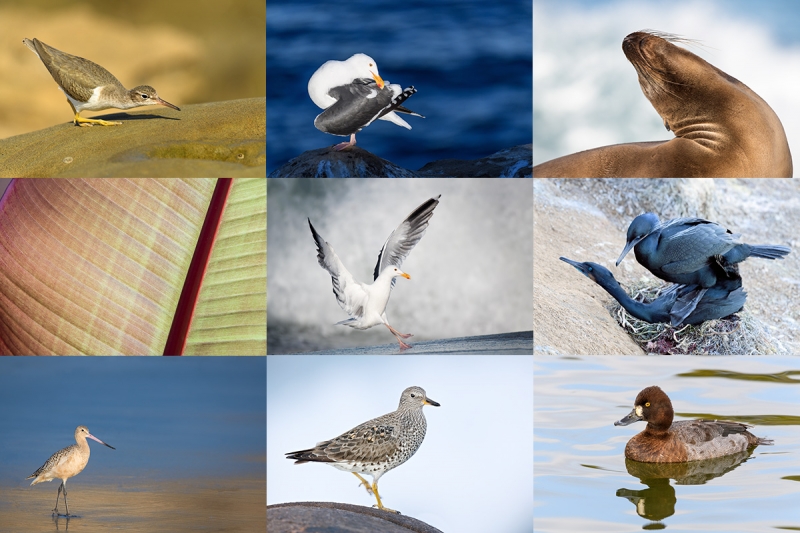


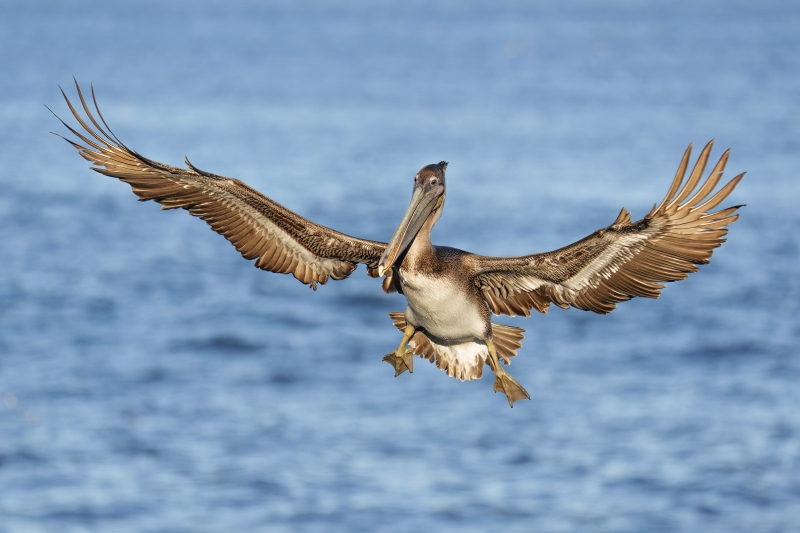
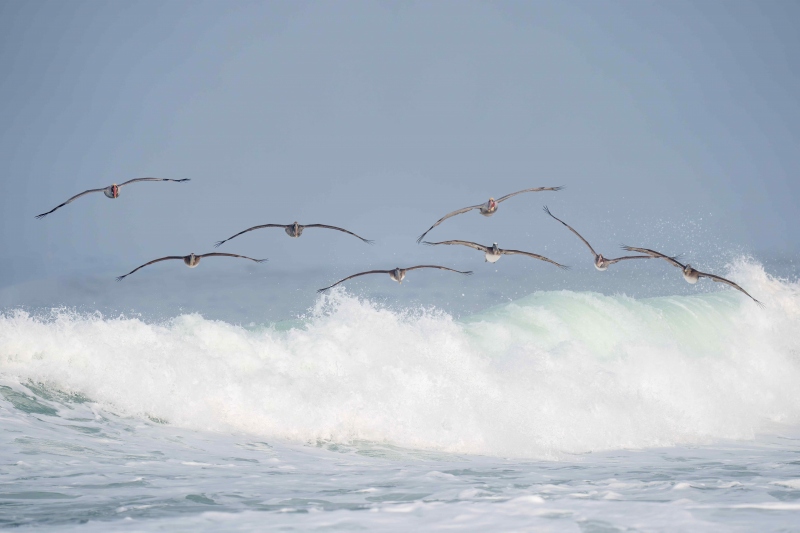
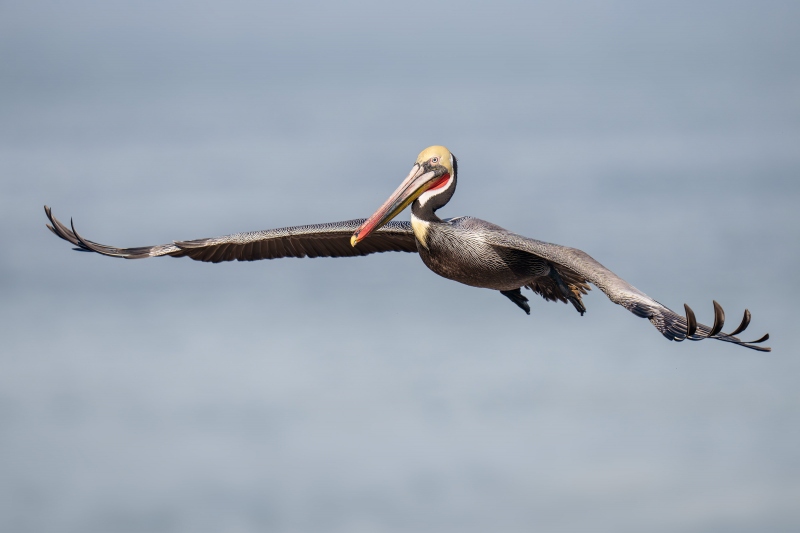
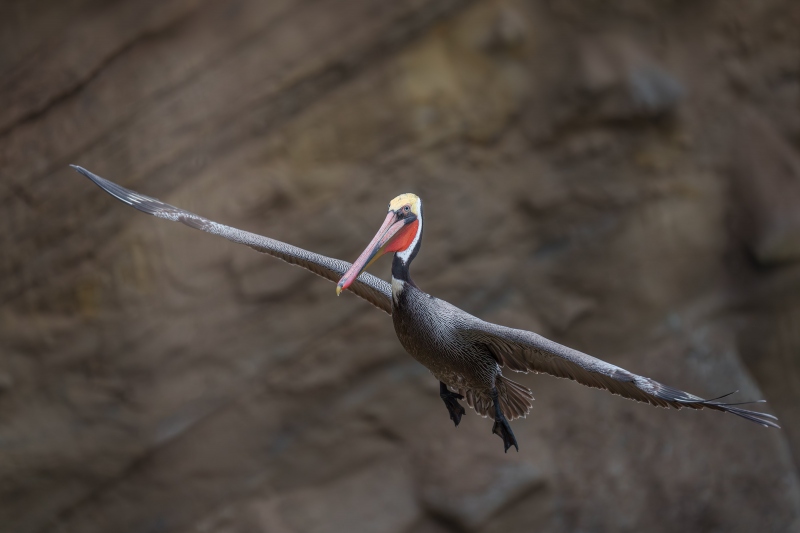
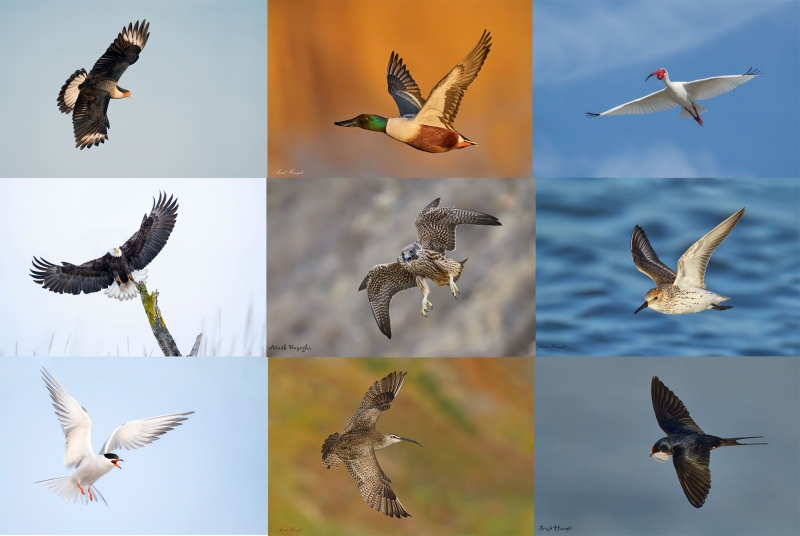













I’m going to swim against the prevailing current and go with #3. I like the spray of the surf. That detail draws me into the pic and makes me wonder how close the bird was to the water’s surface or how big the waves were.
I prefer image 4.
Artie,
Like position of the pelicans above the breaking wave in #2. The light in #1 is really nice. Regarding the DOF, the pelican is closer in image #1.
I’ll go with image 2 because I get 8 for the price of 6.
Cool shots. For DOF, the water and bird are probably closer together in #1.
Thanks and good thinking.
a
Image #1 and #2 and #3 and #4 and #5 with Brown Pelican are good made and cute! And the 3 other images of 9 or more birds are well made and interesting!
Hi Artie,
typo – To learn to evaluate a variety of flight photography situations live an in person, consider joining me on one of the two San Diego IPTs listed above. s/b …and in person…
Thanks for the good catch.
a
I’ll go with #1. Love the sweet light and the landing gear down pose. As for the DOF it looks like you’re shooting slightly down on the bird, bringing the background closer.